The diagram above illustrates the feet of five species of birds. Each foot is particularly well adapted for a certain environment and lifestyle.
Which animal would be found in an environment similar to that of a bird in D?
Exhibit:
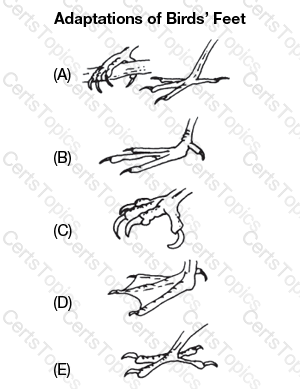
Different enzymes in the human digestive system can digest food material only at specific levels of acidity (pH).
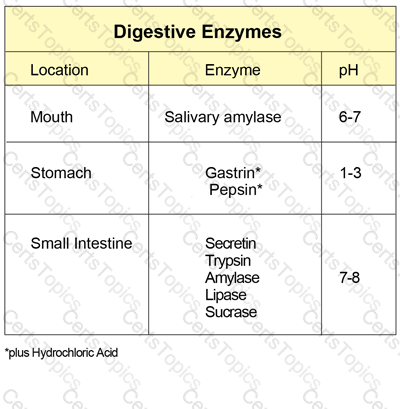
Based on the information, what can be concluded about enzymes in the digestive system?
-- Exhibit --
Radio waves, microwaves, infrared radiation, visible light, ultraviolet radiation, X rays, and gamma rays are forms of radiant energy that make up the electromagnetic spectrum. Each portion of the electromagnetic spectrum has waves that vary in frequency and wavelength, but all can be used by people. Radio waves can be used to carry music and voices for great distances through air, X rays can be used for diagnostic work in medicine, and infrared radiation can be used for heating and drying.

-- Exhibit --
What appears to be the difference in the waves when moving from radio waves to X rays in the electromagnetic spectrum?
For which activity is an environmental scientist likely to be qualified?
Science is a systemized body of knowledge based on observation and experimentation. Technology involves applied science and the practical applications of scientific knowledge. The making of lenses for eyeglasses is a technology that is based on the scientific principles of optics explaining how light rays are bent by finely ground lenses.
Which example would be considered science rather than technology?
As pressure in a closed container is increased, the volume, or amount of space that a gas takes up, decreases. Divers who work underwater use tanks containing oxygen in order to breathe. The amount of oxygen in the tanks allows the divers to stay underwater for some time, yet the tanks are not huge.
Which statement best explains this occurrence?
Earth’s atmosphere contains naturally-occurring ozone. Ozone, which contains three oxygen atoms joined together (O3), forms a layer miles above Earth’s surface. The layer serves as a shield from the harmful ultraviolet rays of the Sun.
A group of chemicals called CFCs (chlorofluorocarbons) are used as refrigerants, propellants, and cleaning solvents. At Earth’s surface CFCs are chemically stable. However, CFC molecules can be broken apart high in the atmosphere and they can destroy the protective ozone layer.
Based on the information, which action would reduce the destruction of the ozone layer?
-- Exhibit --
The carbon cycle is illustrated above. Two of the essential processes involved are photosynthesis in green plants and algae and respiration by almost all organisms. Respiration, as well as burning and other natural decomposition (breakdown) processes, contributes to the amount of CO2 in the air and soil. Photosynthesis uses up CO2 and produces O2, which, in turn, is used up in respiration and the burning of fossil fuels such as coal, oil, and gas.
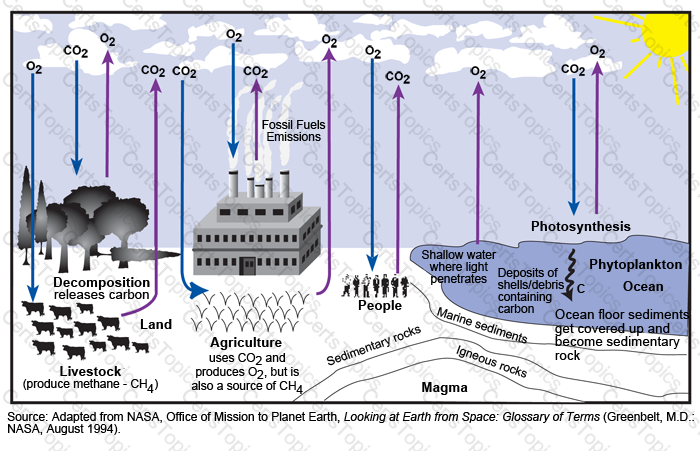
-- Exhibit --
Based on the information and diagram, which process does not release CO2?
A polar bear’s furry coat protects the bear from the frigid air temperature. Similarly, a covering of ice floating on a pond of water protects the fish that inhabit the pond.
Why does water remain in a liquid state below the surface of ice?
Based on the diagram,

at which point is the least amount of force needed to move the weighted box?
In a population cycle, predators eat and reduce the number of prey. If the number of predators is reduced, the number of prey will gradually increase. Eventually, the predator population will increase, and the population cycle will continue.
Which pair best demonstrates a predator-prey relationship?
-- Exhibit --
The pH scale is a measure of the acidity of a substance. The numerical range of the scale is from 0.0 to 14.0. A midpoint pH of 7.0 designates a neutral substance (neither acid nor base). A pH lower than 7.0 denotes an acid substance, whereas a pH higher than 7.0 denotes a basic substance.
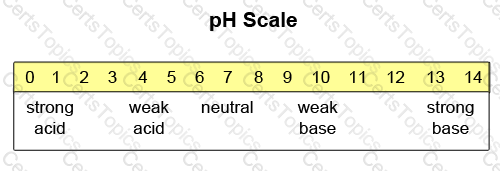
-- Exhibit --
Which of the following substances is the MOST basic?
A steel ball fits exactly into a hole in a wooden block. If the steel ball is heated, which of the following will occur?
Some recipes suggest that certain foods, such as sauces and frostings, be prepared in a double boiler, such as the one shown at the left.
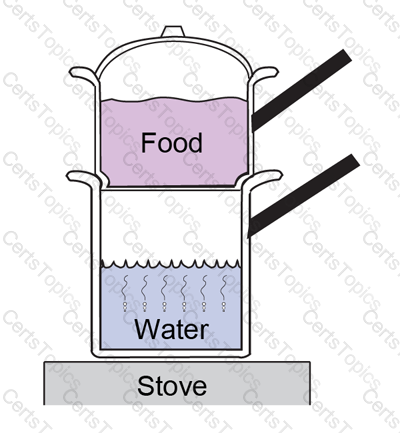
Which statement best describes the advantage of using a double boiler?
The human body’s endocrine system, which keeps the body in a healthy balance, consists of glands that release chemical substances called hormones into the bloodstream. The endocrine glands and the functions that they regulate are shown in the table below.
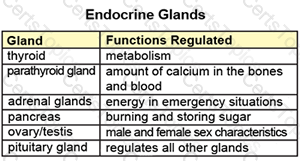
Many adults have some form of diabetes. Based on the information and table, which gland is primarily responsible for regulating blood sugar level?
Many scientists believe that early in Earth’s history, life began in water, aided by the energy from sunlight. Dissolved molecules probably bonded chemically with each other to produce increasingly complex organic molecules called “heterotroph aggregates.” These molecules eventually developed the ability to reproduce.
Why are heterotroph aggregates not found on Earth’s Moon?
Work is done on an object when a force is applied, causing the object to move.
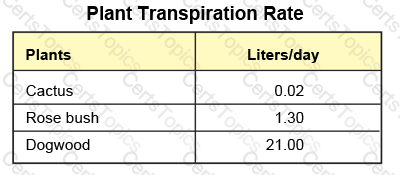
Which example best illustrates this scientific idea?
Blood typing is essentially a chemical reaction that provides data so that blood may be safely transfused from one person to another. The basic objective is to avoid “clumping” that could occur in the recipient when the wrong blood type is received. These “clumps” of red blood cells could block arteries or veins affecting the blood flow to critical body organs, like the heart or the brain.
Exhibit:
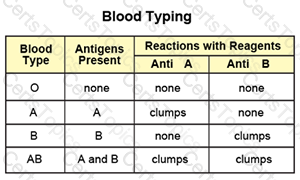
Based on the chart and the information, which blood type will not form clumps with either Anti-A reagent serum or the Anti-B reagent serum?
Exhibit:
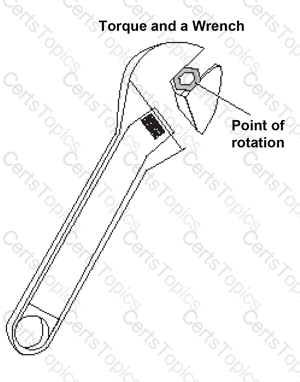
Torque is the measure of a force that produces rotation. A wrench is used to loosen a bolt as shown at the left. The bolt is stuck, so it will require much more torque than is usually needed.
Which replacement given below is most likely to produce the required increase in torque for the wrench?
One wavelength is the distance from one crest of a wave to the next crest or from a trough (low point of a wave) to the next trough. The frequency of a wave is the number of crests that pass any given point each second.
Which of the following waves demonstrates the LOWEST frequency?
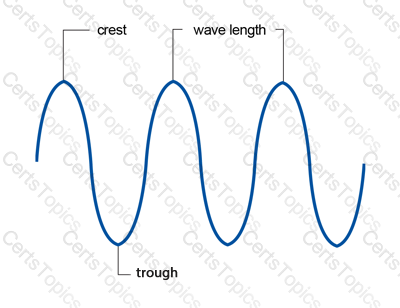
A)

B)

C)

D)

E)

-- Exhibit --
Since carbon dioxide dissolves in water to form an acid, an acid-base indicator such as bromthymol blue is used to track the acid concentration during plant photosynthesis and respiration. Bromthymol blue turns yellow in an acid solution and remains blue in a basic solution. The color change is reversible. A student used the following procedure to track carbon dioxide.
In an experiment, a student placed a solution of bromthymol blue into each of two flasks, inserted a drinking straw in each flask, and blew through the straw until the solution turned from blue to yellow. Carbon dioxide, a waste product in the student’s breath, caused the color change. The student then placed a small Elodea water plant in each flask and closed the flasks with rubber stoppers. Flask A was placed in bright sunlight, while flask B was placed in the dark for 24 hours, as shown in the figure below.
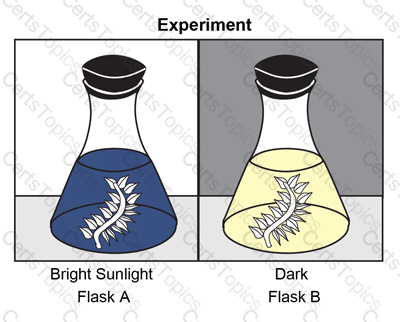
After 24 hours, the bromthymol blue in flask A had turned back to blue, while in flask B it was still yellow.
-- Exhibit --
What relationship was the experiment designed to explore?
The relationship between light and:
-- Exhibit --
The most realistic description of energy flow through an ecosystem is a food web that represents an interconnected series of food chains. In general, the greater the number of alternative channels through which energy can flow, the greater the stability of the food web and the ecosystem.
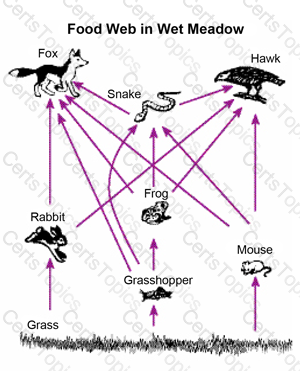
The diagram shows a typical food web for a wet meadow. The hawk and the fox obtain nourishment by preying upon rabbits, frogs, snakes, and mice. The fox may even eat grasshoppers. If, for example, the rabbit population is reduced, possibly because of bad weather during the breeding season, the fox and hawk would shift their predatory pressure to other forms of prey. The rabbit population would then have a chance to bounce back and the ecosystem would remain stable.
-- Exhibit --
Based on the diagram, which consumer would have the greatest chance of surviving if the amount of available prey changes during the different seasons?
Many years ago, beavers were introduced to a region of California that they had not previously inhabited. Forty years later, the beaver population had grown so much that a cluster of aspen trees used by the beavers for food and building materials inside the national forest became endangered. The beavers were also interfering with the water systems.
In retrospect, how would biologists most likely evaluate the impact of the introduction of the beaver?
Every radioactive element has a specific half-life, which is the amount of time it takes one-half of a sample to decay. The following graph shows the radioactive decay of 2000 grams (g) of Iodine-131. Iodine-131 has a half-life of about 8 days. So after 8 days, one half of the original sample, or 1000 g, of Iodine-131 remains.
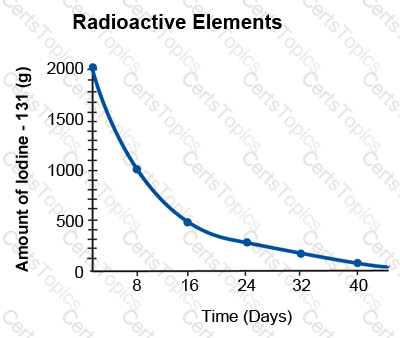
Using the graph on the left, how much of the original 2000 g of Iodine-131 will remain after it has undergone radioactive decay for 16 days?
During an electrical storm, a lightning flash is seen before the sound of thunder that it generated can be heard. The farther a person is from the storm, the greater the time interval between the light flash and the arrival of the sound. Which of the following statements best explains this phenomenon?
Air is a mixture of gases, mostly nitrogen and oxygen, but it also contains a small amount of water vapor. Depending on its temperature, water can exist in any of the three states of matter.
In the diagram at the left, water droplets have formed on the outside of the can, and the can contains pieces of ice.
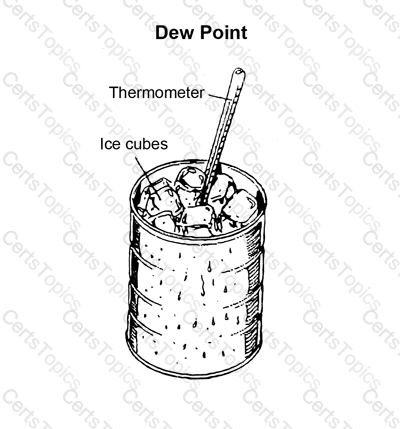
Based on the information and diagram, which statement regarding the droplets on the outside of the can is the most accurate?
Flowers are the reproductive part of some plants. The stamen is the male reproductive organ while the pistil is the female organ. At the tip of the stamen is the anther, which forms pollen grains in which the sperm cells are formed. Pollen grains are transferred to the pistil by wind, water, insects, and other mechanisms.
Which statement best interprets the diagram and information?
Exhibit:
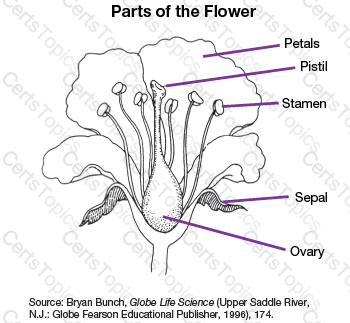
When choosing an organism to study, geneticists prefer the following characteristics. The organism should be small, have a fast growth rate, and have the ability to produce many offspring.
Based on these criteria, which plant would be LEAST useful for a genetic study?
-- Exhibit --
Since carbon dioxide dissolves in water to form an acid, an acid-base indicator such as bromthymol blue is used to track the acid concentration during plant photosynthesis and respiration. Bromthymol blue turns yellow in an acid solution and remains blue in a basic solution. The color change is reversible. A student used the following procedure to track carbon dioxide.
In an experiment, a student placed a solution of bromthymol blue into each of two flasks, inserted a drinking straw in each flask, and blew through the straw until the solution turned fromblue to yellow. Carbon dioxide, a waste product in the student’s breath, caused the color change. The student then placed a small Elodea water plant in each flask and closed the flasks with rubber stoppers. Flask A was placed in bright sunlight, while flask B was placed in the dark for 24 hours, as shown in the figure below.

After 24 hours, the bromthymol blue in flask A had turned back to blue, while in flask B it was still yellow.
-- Exhibit–
The experiment was designed to track what substance?
Catalysts are chemical substances that increase the rate of a chemical reaction but are not changed by the reaction. Enzymes are special catalysts produced in body cells and are composed of proteins.
Which statement is true?
Based on the information, where would one find wispy, feathery clouds?
Based on the information,
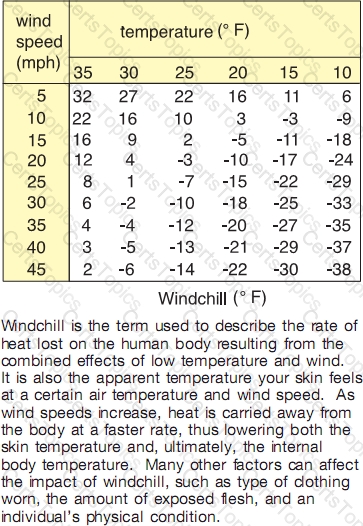
Which practice would best protect a human being from the damaging effects of windchill on a severe day?
Yeast is a fungus that is used in making bread. As the yeast cells reproduce and feed, they ferment sugars to produce ethyl alcohol and carbon dioxide gas. The carbon dioxide forms bubbles in the dough, causing the dough to rise. How fast the dough rises depends on temperature.
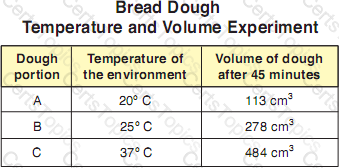
Three portions of dough weighing exactly the same are allowed to rise for 45 minutes at three different temperatures. At the end of forty-five minutes, the volume of each portion is measured. The results of the experiment are listed in the table at the left.
Based on the chart, which statement is an accurate conclusion?
If you had a freshwater fish tank in your home, which type of algae would most likely survive in that type of environment?
To begin a fission reaction, a neutron is shot at high speed into the nucleus of an atom of Uranium-235. This process releases a large amount of energy contained within the nucleus. The diagram above illustrates this process as well as possible by-products.
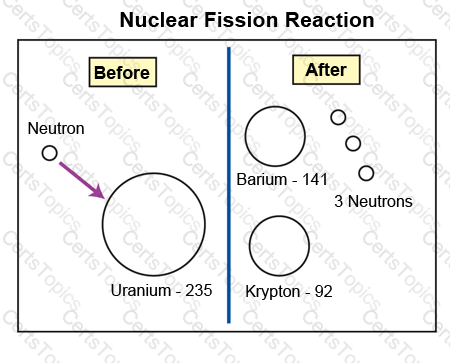
Based on the diagram and information, which statement best describes the fission reaction shown?
The widespread use of antibiotics has created a frightening threat to our safety. While antibiotics have offered life-saving treatment for countless diseases, their misuse and overuse have contributed to the evolution of deadly bacteria that are resistant to treatment. Although there is a reluctance to give up the demand for antibiotics, most people accept scientists’ warnings of impending catastrophe.
Which choice best explains why doctors now prescribe antibiotics less often than in the past?
Wheat is the staple cereal for most of the world. Flour is made from the kernel of the wheat plant. The kernels are first separated from the plant stem and then broken apart by the milling process. The husk, the outer layer unusable for most purposes, is removed.
The wheat kernel (whole grain) has three main parts: germ, bran, and endosperm. The germ is especially rich in vitamin E, niacin, and riboflavin. The bran, a protective coating around the kernel, is also a rich source of nutrients and fiber. The endosperm, making up 83% of the kernel, is the soft inside portion containing starch and proteins.
Although the enrichment of white flour restores some of the lost nutrients, there are some vitamins and minerals that are lost in the refining process and not replaced. A valuable source of fiber is also lost.
Ling reads an article that states that many people don’t get enough fiber in their daily diet.
Which type of bread would be the best to recommend to Ling?
Why is algin used in a chocolate milk shake?
Exhibit:
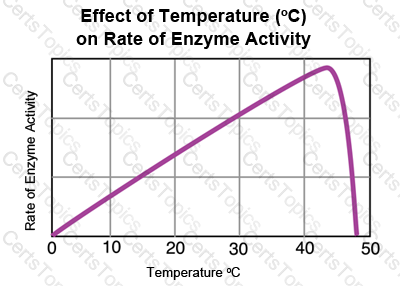
Based on the graph above, after which of these temperatures (Celsius) does enzyme activity begin to first show a decrease?
Line spectra, a series of bright lines, are shown above for several elements. Scientists find these spectral lines, which are essentially a set of chemical "fingerprints," to be useful for the identification of elements. Each element produces a unique series of spectral lines referred to as an emission spectrum. An unknown sample can be identified by matching spectral lines with those of a known element.
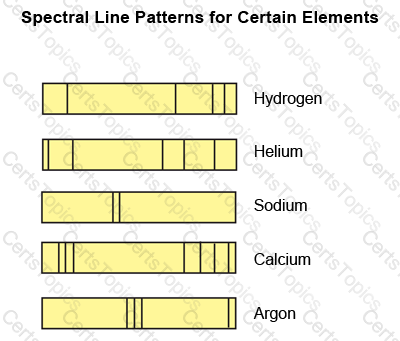

Based on the information and diagram, which element is present in the sample shown on the left?
Potential energy is stored energy. Kinetic energy is energy of motion. Conduction is the transfer of energy when molecules collide. Convection is the transfer of heat caused by density differences in air.
What type of energy change is demonstrated when a child, starting from the top, goes down a play slide?
The battery of an automobile produces electricity from a chemical reaction. This electricity leaves the battery from a post called a terminal and is used in starting the engine. Sometimes a crusty deposit forms on the terminals, preventing the engine from starting. Simply cleaning off the deposit often restores the battery to operable condition.
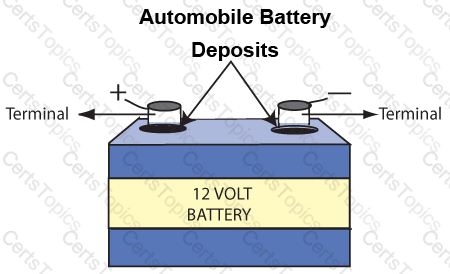
Which effect does the deposit have on the battery terminals?
Susan is studying air pressure and makes a simple mercury barometer as shown below. She knows that air exerts pressure. More pressure on the surface of the mercury in the bowl will cause the mercury level to rise. Less pressure will cause the mercury to fall. High barometric pressure is often associated with fair weather, and low barometric pressure is associated with rain.
Susan is enjoying a bright, sunny day when she hears a local weather forecaster predict rain for tomorrow.
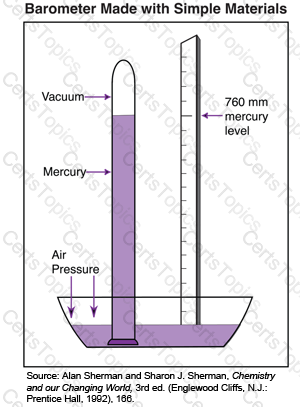
When Susan checks her barometer tomorrow, which change is she most likely to note?
Windchill is the rate of heat loss on the human body resulting from the combined effects of low temperature and wind. As wind speeds increase, heat is carried away from the body at a faster rate, thus lowering both the skin temperature and, ultimately, the internal body temperature. Many other factors can affect the impact of windchill, such as type of clothing worn, the amount of flesh exposed, and an individual's physical condition.
Based on the information provided, which of these practices would BEST protect a person from the damaging effects of windchill on a severe day?
Scientists often place living organisms into related groups for the purpose of studying their physical characteristics. The diagram below shows five single-celled organisms.
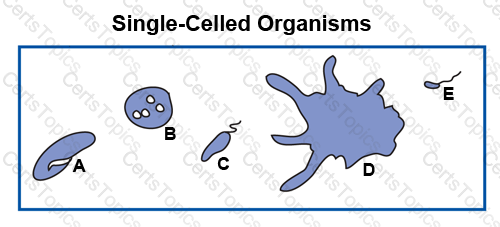
Based on the above information and diagram, using the similarities of physical traits, which pair of organisms might be grouped for scientific study?